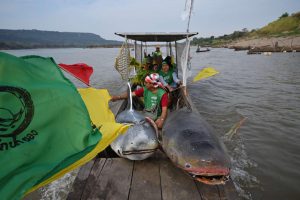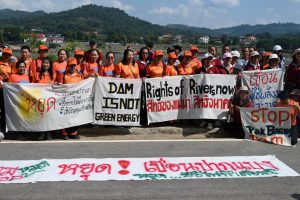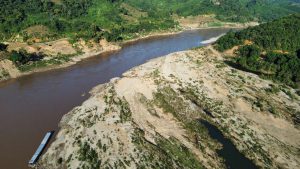6 July 2019
Pursuant to the Chinese Embassy Spokesperson’s Remarks on the Media Report on the Mekong, which alleges that the media is targeting China based on groundless and inaccurate information and insufficient attention has been paid to the effort of concerned parties, including China and Thailand, to promote cooperation regarding the Mekong’s water resources.
The Thai Mekong People’s Network from Eight Provinces issues this response on the following four points.
1. On Ecological and Environmental Protection of the Mekong River
Our response: The Mekong’s water resources have been shared and used by people since ancient times, subject to the management that ensures justice to all countries and groups of people to equally benefit from nature and our shared resources, including through fishing, navigation, agriculture, water supply, etc.
Due to the emergence of Mekong development initiatives, including large-scale development projects such as the damming of the Mekong and its tributaries and the blasting of rapids to pave the way for commercial boat navigation, the Mekong’s water resources have been subjected to unfair destruction and management at the behest of large corporations that stand to gain immensely from the exploitation of our shared resources.
We are bearing witness to the plunder of resources from local people to serve the vested interest of large corporations. The so-called “Green” aspect of the China-Laos Railway project is at the conceptual level only, in the absence of any concrete plan as to how the project’s destruction of natural resources and the livelihoods and economies of local populations, can be alleviated. While the project is under development, it has drawn strong criticism from the public due to extensive adverse impacts on people and the environment.
Our environment is already intrinsically “green” and provides an abundance of natural resources. This wealth is now being eroded by various so-called “green” development projects. The Green Lancang-Mekong Plan therefore represents a farcical paradox in itself.
2. On the Mekong “Rapids Blasting”
The following is our response regarding the Mekong rapids blasting project, linked to the development of ‘commercial navigation’ on the Lancang-Mekong River. This project has been implemented since 2000 per the ‘Agreement on Commercial Navigation on Lancang-Mekong River’ between the four riparian countries, which includes rapid blasting as an integral part.
The rapids blasting on the upper reaches of the Mekong in China, toward the Myanmar-Lao border in the Golden Triangle, has been completed. As a result of its implementation, the Mekong’s ecological system and the livelihoods of people downstream have been exposed to various adverse impacts. In recognition of this, the Thai government during 2003-2004 decided to suspend the project citing national security concerns and social and environmental impacts.
Notwithstanding this decision, the project was revived during meetings of the Lancang-Mekong Cooperation Framework (LMC) by the Chinese government, and Thailand allowed the design survey to proceed along the 97kilometer stretch on Thailand-Laos border.
The Network’s position is that the decision to press ahead with the survey of rapids, boulders, cliffs, beaches and shoals, in order to identify them for blasting to canalize the river, can only be taken after completing a thorough Environmental Impact Assessment and a comprehensive study of both adverse impacts and benefits, including transboundary impacts. Nonetheless, the Thai government has permitted the survey without first considering all potential impacts and vulnerabilities. This shows that the continuous efforts of the Chinese government to push through the canalization project have not ceased.
During the ‘consultation’ meeting in January 2019 in Chiang Rai’s Wiang Kaen and Chiang Saen, the people who participated in the event expressed their serious concerns about the project. At the meeting, the project to survey and ‘improve’ the 13 rapids as shown in the map was presented merely as the surgical removal of some small rocks. The areas are in fact not just small rocks, but gigantic rapids that are slated for removal by blasting. The Mekong canalization project plans explicitly state that, along the six-kilometer-stretch, a massive amount of 20,000 tons of rock must be excavated.
Participants in the consultation meeting pointed out a clash of perspectives, the engineering perspective on the one hand and the natural or environmental perspective on the other. According to the project plans, the excavated rocks from the blasting will be deposited in deep pools along the river. But for local people, these deep pools are in fact extremely important fish habitat, which provide for the foundation of the community resources. Furthermore, once the project is completed, the commercial boats will navigate the river not just one day, but every day. The project documents explicitly acknowledge local people’s opposition to he project for over ten years.
Some participants voiced their concern that the project will disproportionately benefit a handful of people whereas local people will not gain anything. At present, the natural balance is maintained and local people can live in, and depend on, this environment. The Mekong’s navigation project will completely upend this balance and inadvertently cause impacts not just for the people in Thailand, but for local people along the river.
3. On the Role of Cascade Hydropower Stations
Our response: To be clear, the “Cascade Hydropower Stations” refers to hydropower dams on the upper reach of the Mekong mainstream in Yunnan Province, China, where ten dams have been completed. Over the past few years, these dams have caused unprecedented fluctuations in Mekong’s flows and levels. Prior to the construction of the dams, there was no such fluctuations. Previously, the water levels rose and receded naturally and seasonally. After the completion of the dams in the upper reach of the Mekong, the water levels, particularly along the Thai-Lao border, no longer follow-seasonal patterns. Rather, it depends entirely on the control of the water discharged from the Chinese dams in the past 20 years.
Discharging water during the dry season and storing water during the rainy season to allegedly “mitigate floods and increase water during dry seasons” is out of sync with nature. Floods along the Mekong are a natural occurrence during rainy season. This is when fish and other aquatic animals swim upstream to the upper reach of the Mekong and its tributaries for spawning and reproduction. As the upper reach dams store water during rainy season, less water flows downstream, upending the natural life-cycle of fish, preventing water flowing into wetlands, which in turn have impacts on the people and the environment.
By storing water during the rainy season, the dams have also prevented the distribution of rich nutrients which are key to the natural abundance of the Mekong.
An increase of discharge during dry seasons cause even more massive impacts downstream. It directly serves the interest of China including its commercial navigation. A sheer increase of water level during dry seasons can be devastating to the ecology and people’s livelihoods downstream. The rapids, boulders, cliffs, beaches and shoals which normally emerge during dry seasons to serve ecological services including providing important habitats to animals are no longer available. Millions of native and migratory birds which used to lay their eggs on the shoals in the middle of the Mekong will lose their habitats and have their reproduction disrupted by the outflow from the dams.
Pivotally important vegetations including Kai or fresh water weed, which not only provide food for fish including the Giant Catfish, but also an important source of food and income for local people, are being impacted by unseasonal fluctuations in water levels caused by the dams. Such vegetation along the whole stretch of the Mekong can no longer grow. Floods that now occur during dry seasons have made the agricultural life along the banks of the river miserable, have upended local cultures and traditions and deprived local people of recreational spaces. The information referred to in the Chinese Embassy Spokesperson’s Remarks can well attest to this.
As to the navigation of local passenger boats, the local people have been able to operate it year-round. This is not unprecedented. What the Chinese Embassy’s Spokesperson’s Remarks is referring to are the Chinese cargo ships which are much larger and are unable to navigate this stretch of the Mekong during the dry season.
Mitigating droughts have been used to justify the discharge of water from upstream dams. However, water in the Mekong does not just derive from precipitation. Some of water comes from melting snow at the origin of the river as well. Much of the water in the upper reach of the Mekong comes from water sources in China itself.
It is mentioned in the Remarks that “In 2013 and 2016, the entire Lancang-Mekong River was struck by severe droughts. China, although hit by the disaster, provided emergency water supplement to the downstream Mekong River….when droughts occur due to extreme weather conditions, upstream water dams play an important role by storing water in the wet season for discharge in the dry season.”
We would like to note that in the same year that the Mekong Basin was hit with drought, there was no such drought in the Salween Basin, which originates from the same source as the Mekong since Salween can run free and undammed. It faces no impacts from the dam storage.
4. On Notification of Hydrological Data
Our response: Data notification which until now has been made through government channels has failed to keep the public sufficiently informed. It has also failed to address transboundary impacts. Most importantly, the notifications have not addressed the impacts on downstream communities and the ecological system.
The Chinese Embassy Spokesperson’s Remarks claim that “The outflow of the Lancang River accounts for only 13.5% of the runoff at the estuary of the Mekong River.” This is only partially true. It is also undeniable that nearly 100% of water in the Mekong at the Thailand border around the Golden Triangle comes from the outflow of the Lancang River, particularly during dry seasons. The operation of the China’s Jinhong Dam inadvertently affects the Mekong that forms the border between Thailand and Laos.
By simply saying “we drink from the same river” does not automatically guarantee our deeply entrenched relations. Rather, a peaceful coexistence of people who share the Mekong River Basin can only be achieved through mutual respect, listening to each other and genuine cooperation among riparian governments and people.
The Network can provide more information and evidence of the damaging impacts on us when we get to meet and discuss the problems. A consultation is necessary to exchange ideas on how to solve the problems and build a path towards a more sustainable and fair use of the Mekong’s water resources together. Such efforts can help to avoid the disputes from becoming worse.




